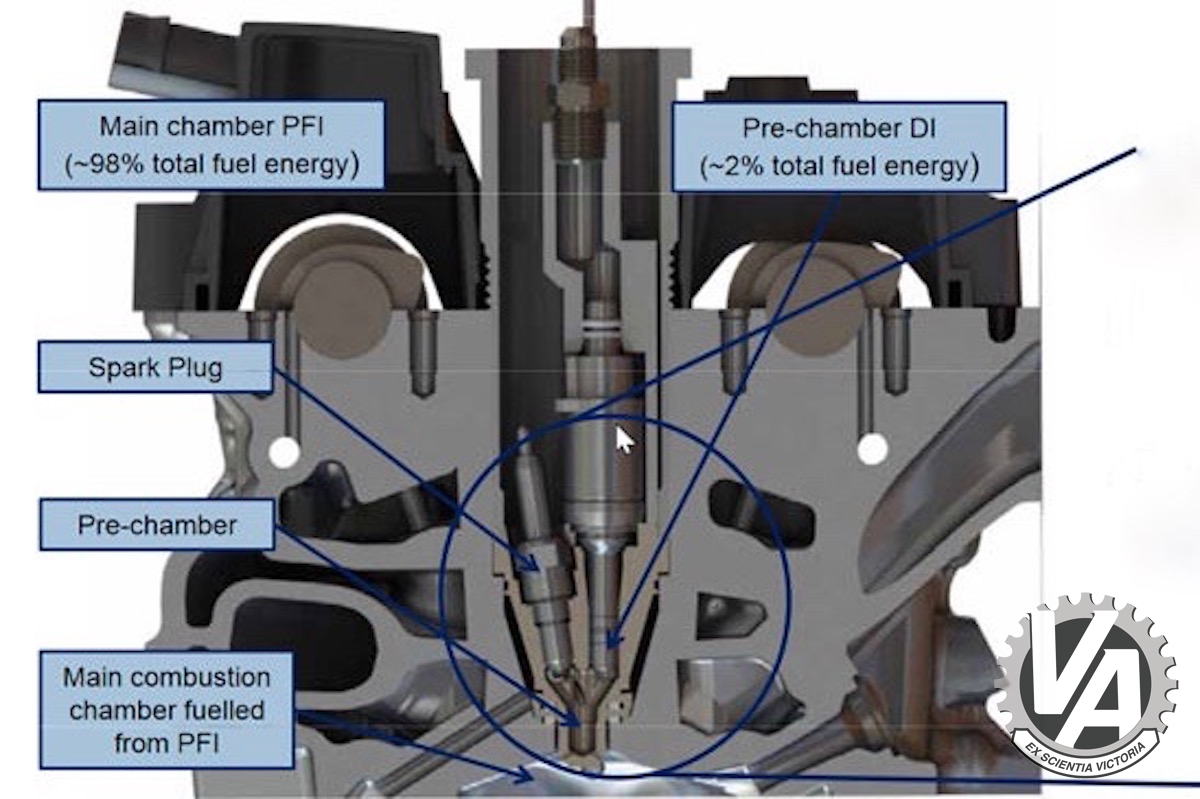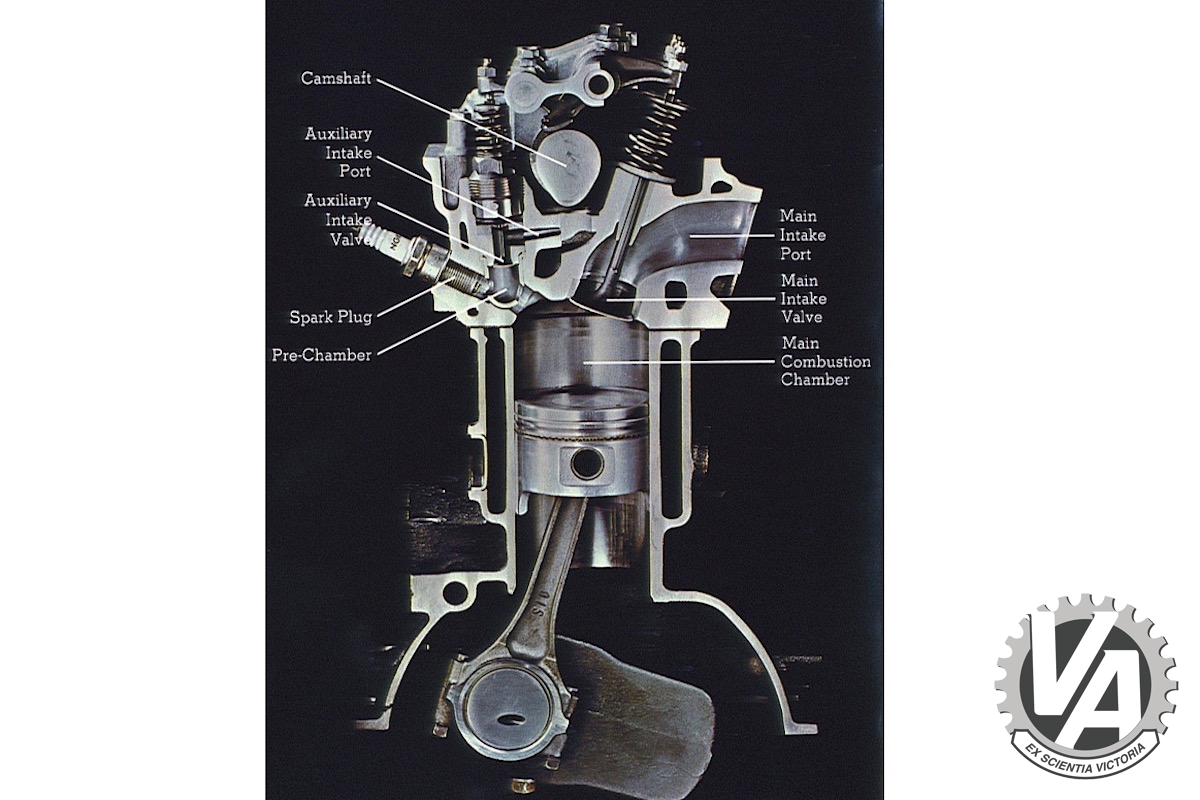
25 May CVCCs in F1?
Is there a CVCC turbo engine in Honda’s future?
By Brian Gillespie
The big news recently in F1 is the huge increase in thermal efficiency (read: power) of the engines for Mercedes and now Ferrari. As you can probably tell by standing near one, internal combustion engines are very inefficient with as much as 75 percent of the energy from combustion bleeding out through the exhaust or in radiant heat. This article in Ars Technica reports that this year’s Ferraris and Mercedes could be nearing 50 percent thermal efficiency. As the Donald would say, “That’s Yuge!”
The big gains are being credited to Mahle’s Turbulent Jet Ignition. The way it works is that there’s a small pre-chamber in the center of the head where you might usually find the spark plug. The pre-chamber has six small ports that point outward toward the edges of the cylinder. When fuel is injected on the intake cycle, a rich mixture is injected into the pre-chamber and a lean mixture is injected into the cylinder. The spark plug, which is in the pre-chamber, ignites the rich mixture, which, in turn, ignites the lean mixture via the six small ports. These jets of flame do a very efficient job of thoroughly burning the lean mixture in the cylinder. The result is a more complete burn of the fuel during the combustion cycle and less wasted energy.
For those of you who follow Honda closely, you may recognize the description of this technology. Yeah, that’s right, Honda’s Compound Vortex Controlled Combustion (CVCC). The 1975 Honda Civic CVCC had the very same technology. The major difference? They used a carburetor instead of fuel injection. Honda came up with this solution in the early 1970s as an answer to the EPA’s pending 1975 emissions standards. They were looking to meet the new restrictions without resorting to after treatment of the exhaust by using catalytic converters. Cats weren’t very cheap and needed to be replaced too often. Also, using a catalytic converter meant using unleaded gas. In the mid-1970s, not every gas station had unleaded gas.
The advent of direct injection and advances in computational fluid dynamics modeling (CFD) have enabled Mahle to bring the CVCC concept to the next level. Direct injection gives a much finer degree of control of the fuel. CFD allows for much of the design and preliminary testing to be done with a computer, reducing the need for expensive and time-consuming prototypes. Reading Mahle’s own presentations, though, it seems like they are trying to take credit for bringing this idea to cars. They mention Honda but make it sound like they only explored the idea. They state: “Pre-chamber combustion concepts are not new” and “…investigated by many OEMs: Honda, VW, etc.,” glossing over the fact that Honda produced CVCC engines in their cars from 1974 to 1985.
Before you get all angry about Mahle ripping off Honda (like I did), Honda didn’t originate the idea of using a pre-chamber in the internal combustion engine. It had been in use in diesel engines since the early 1900s. The Honda engineers who developed CVCC say they investigated the Russian Nilov engine developed in the late 1950s. The Nilov engine had a pre-chamber fed by a separate carburetor—not quite as elegant as Honda’s carburetor with two progressive barrels feeding the cylinder and a third, very small barrel feeding the pre-chamber. The Nilov engine was probably developed to better ignite the poorly refined gas in the Soviet Union rather than reductions in emissions. There was also a fuel-injected version called the Heinz ram-straticharge that was tested by Chrysler but never made it into production. In the end, Honda was the first company to successfully manufacture and sell this stratified-charge gasoline engine. Interesting note: if not for the Civic CVCC, Honda might not have stayed in the car business. That story is here.
What is really intriguing is that F1 is using the technology. When Honda developed the system it was to decrease pollution. Excess hydrocarbons and carbon monoxide result from unburned fuel near the edges of the piston and near the cylinder wall. Nitrogen oxide forms from the high temperatures in the cylinder. Run your mixture too lean and it may not burn completely, giving off HC and CO. Run it rich enough to burn completely and you get raised levels of NOx. The lean mixture coming into the cylinder wasn’t always homogeneous. So the spark from the plug didn’t always completely burn mixture. Jets of flame coming from the CVCC pre-chamber were much more efficient at achieving complete combustion of the lean mixture.
But no one says you have to run a lean mixture. If you have a naturally aspirated race engine, a slightly rich mixture will produce the most power. So, could you enhance the burn and power using a CVCC-like pre-chamber to ignite a richer mixture? Would it burn more completely and quickly raise cylinder pressure to produce more power? What about turbocharged systems? Would the CVCC flame jets do a better job of igniting the dense air and fuel charge? Would it change the pressure wave and maybe enhance its effect on the turbine? Obviously, Ferrari and Mercedes are having success with the turbos and Mahle’s CVCC-like turbulent jet ignition.
I guess the real question here is: Is there a CVCC turbo engine in Honda’s future?



No Comments